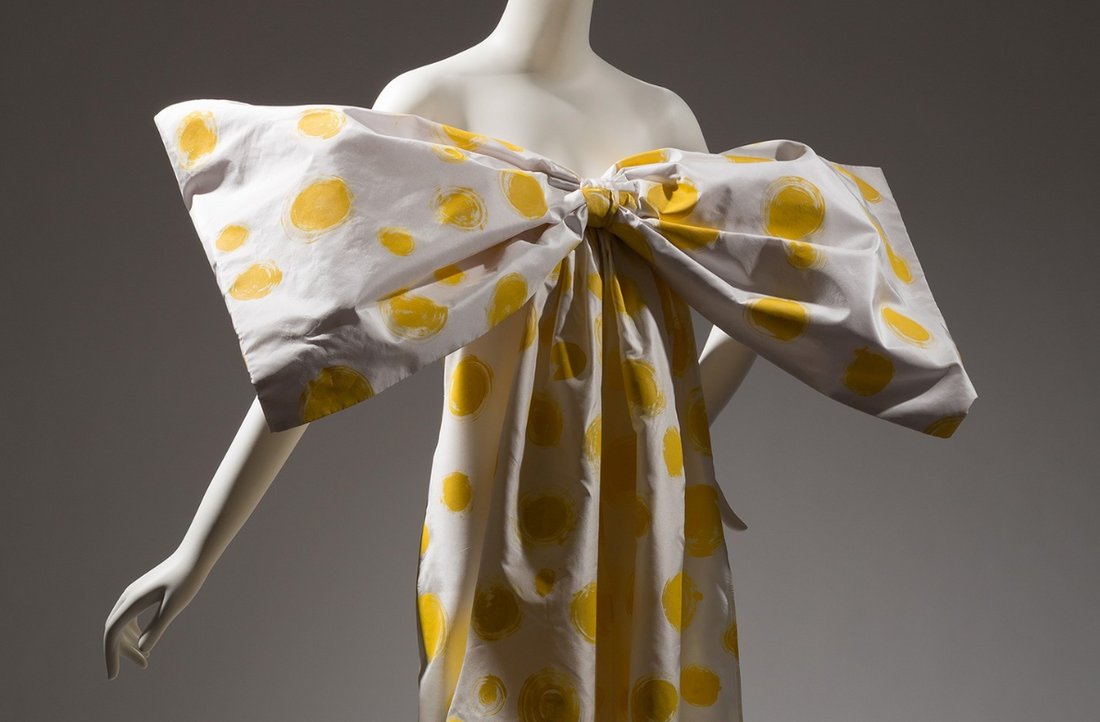
Untying the Bow at The Museum at FIT
Untying the Bow is presented in three thematic sections: Form and Functions begins by tracing the bow’s utilitarian origins. The next section, Status and Gender, explores the “bow’s” symbolism as a marker and subverter of status and gender. Finally, in Abstraction, the exhibition examines how the symbolism of bows has evolved into abstract forms and patterns. Experiments with scale and technique have allowed bows to transcend their original form to become captivating motifs. Untying the Bow is a transformative journey, unraveling the hidden narratives and cultural expressions that have elevated the bow from a mere structural element to a timeless icon in fashion.

Image: Victor Edelstein, evening dress, black velvet and pink satin, 1987, USA, gift of Anna Wintour, 88.70.1. Image above: Ágatha Ruiz de la Prada, dress and detachable bow in white silk taffeta with hand-painted yellow dots, spring/summer 2014, Spain, gift of Ágatha Ruiz de la Prada.
Form and Function offers insights into how the simple yet versatile bow knot influenced the structure and use of the bow, highlighting its role in the stays and corsets that shaped women's torsos throughout the 18th and 19th centuries. A circa 1937 hat by Lilly Daché borrows the silhouette of the turban, which provided a practical method of keeping hair back and was often worn by factory workers. Despite this practical purpose, the hat’s fashionable appearance was also a concern; the tensions between bows as a feminine fashion element and their omnipresence in menswear on neckties and hats are also explored.
Status and Gender moves beyond the bow’s utilitarian purpose to explore symbolism, focusing on how the bow can reinforce and subvert traditional expectations through shifting material costs, placements on the body, and abundance. The bow has evolved into a potent symbol with a number of styles and iterations. This section of the exhibition challenges pre-existing beliefs about the bow’s importance in the world of fashion. For example, pair of whimsical Carel women’s ankle boots humorously reinterpret the formality of a tuxedo and bow-tie ensemble by bringing these design elements to the feet.
 Image: Carel, ankle boots, leather and patent leather, spring 1984, France, gift of Tony Carel, 84.190.1.
Image: Carel, ankle boots, leather and patent leather, spring 1984, France, gift of Tony Carel, 84.190.1. Bows can also be used with sophistication. This is exemplified by a 1987 Victor Edelstein gown gifted to the museum by Anna Wintour, editor-in-chief at Vogue since 1988, which features a large satin bow at the center back. Contrasted with matte black velvet, the shining, structural pink bow stands out as the focal point of the gown. Prominent bows on cocktail dresses and evening gowns are a hallmark of 1980s fashion excess and, like the bow, the colour pink has a long and varied history with similar shifting cultural perceptions. By the time this gown was made, pink was relegated primarily to women’s wear. The combination of these two overtly feminine elements creates a striking and powerful image, fittingly worn by one of the most influential women in fashion today.
The third section, Abstraction, further explores the bow’s symbolism. As the bow transcended its original functional form, its physical presentations became more abstract. Manipulation of scale, dimensionality, and repetition breathed new life into this age-old fashion icon, especially during the 20 and 21st centuries. In different scales and iconography, bows emphasise dressing as an act of decorating and presenting oneself. A playful polka-dotted evening dress by designer Ágatha Ruiz de la Prada from 2014 features a huge, maximalist bow at the center of the strapless bust. Enlarging its dimensions transforms the bow into the garment’s focal point. A different form of abstraction is the bow as a motif. A 1934 evening dress exemplifies the physical reduction of bows into a flat design, by playing with both dimensionality and the printed motif: The appliqué bows decorating the neckline are cut from the red bows printed onto the dress’s ivory linen fabric.
Accompanying the clothing and accessories in the exhibition are historical and contemporary images of the myriad unique and artistic ways that the bow—born from function—has morphed into stylistic inspiration. In addition, a video documents how the bow has dominated contemporary fashion.
Images courtesy of The Museum at FIT
Untying the Bow is on show at The Museum at FIT from 1-24 March 2024.
Find out more and plan your visit.
